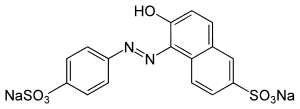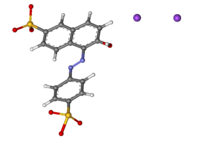日落黃
| 日落黃 | |
|---|---|

| |

| |
| IUPAC名 Disodium 6-hydroxy-5-[(4-sulfophenyl)azo]-2-naphthalenesulfonate 6-羥基-5-[(4-磺酸基苯基)偶氮]-2-萘磺酸二鈉 | |
| 英文名 | Sunset Yellow FCF |
| 別名 | 橙黃S、FD&C黃色6號(美國)、食用黃色五號(臺灣)、C.I. 15985、E110 |
| 識別 | |
| CAS號 | 2783-94-0 |
| PubChem | 6093232 |
| ChemSpider | 11431290 |
| SMILES |
|
| InChI |
|
| InChIKey | OIQPTROHQCGFEF-JLAJEUQUBH |
| KEGG | C19531 |
| 性質 | |
| 化學式 | C16H10N2Na2O7S2 |
| 摩爾質量 | 452.37 g·mol−1 |
| 外觀 | 橙紅色粉末 |
| 熔點 | 300 °C(573 K) |
| 溶解性(水) | 可溶於水 |
| 危險性 | |
| NFPA 704 | |
| 若非註明,所有數據均出自標準狀態(25 ℃,100 kPa)下。 | |
日落黃(Sunset Yellow FCF),是一種人工合成的橘橙色偶氮類酸性染料,是從石油中製造出來的芳香族烴類。當在食品及飲料中作食用色素使用時,根據法例需在其成份標示:在美國售賣時,會標明FD&C Yellow 6;在歐洲售賣時,會標明其E編碼E110[1];在台灣售賣時,會標明黃色五號。[2]
應用[編輯]
日落黃主要用於食品、飲料、日用化妝品及藥物作食用色素[3][4][5][6]:4。舉例說:可用於糖果、甜點、小吃、醬料及涼果等[7]:463–465。日落黃常與另一種叫作E123的莧菜紅著色劑一起使用,以產生巧克力或焦糖的那種棕色效果[8]。
安全性[編輯]
無論是歐盟或世衛還是聯合國糧農組織的指引,日落黃的一日可接受攝取量(ADI)都是0-4 mg/kg[7]:465[9] 。日落黃在現時使用量方面沒有致癌性、基因毒性或發育毒性。[7]:465[9]
自1970年代後期以來,在Benjamin Feingold的廣泛宣傳下,有指日落黃等食用色素可能會導致兒童的食物不耐症和注意力不足過動症(ADHD)行為。 但這些説法無確實科學根據。[10]:452 某些食用色素可能會成為遺傳預先傾向性的觸發因素,但證據不足。[11][12]
作食品添加物使用的監管[編輯]
歐洲[編輯]
目前日落黃在挪威、芬蘭及瑞典都被禁止作食品添加物使用[需要較佳來源][13][14]。
美國[編輯]
日落黃在美國被稱為FD&C黃色6號(FD&C Yellow 6),被批准用於食用色素、藥物和化妝品中,其規定的一日可接受攝取量(ADI)為3.75 mg/kg。[12]:2,7
參見[編輯]
參考文獻[編輯]
- ^ Wood, Roger M. Analytical methods for food additives. Boca Raton: CRC Press. 2004. ISBN 1-85573-722-1.
- ^ 食品添加物使用範圍及限量暨規格標準_消費者專區. consumer.fda.gov.tw. [2021-12-27]. (原始內容存檔於2021-12-27).
- ^ Codex Alimentarius (Codex GFSA) Online. Updated up to the 37th Session of the Codex Alimentarius Commission (2014) Sunset yellow FCF (110) (頁面存檔備份,存於網際網路檔案館)
- ^ FDA December 2009 Color Additive Status List (頁面存檔備份,存於網際網路檔案館)
- ^ EU Food Additive Database Sunset Yellow FCF/Orange Yellow S (頁面存檔備份,存於網際網路檔案館). Database accessed 6 December 2014]
- ^ European Medicines Agency 19 June 2007 [Guideline on Excipients in the Dossier for Application for Marketing Authorisation of a Medicinal Product]
- ^ 7.0 7.1 7.2 Abbey J, et at. Colorants. pp 459-465 in Encyclopedia of Food Safety, Vol 2: Hazards and Diseases. Eds, Motarjemi Y et al. Academic Press, 2013. ISBN 9780123786135
- ^ Food: The Chemistry of Its Components. 英國皇家化學學會. [2014-12-06].
- ^ 9.0 9.1 EFSA Panel on Food Additives and Nutrient Sources added to food (ANS) https://www.efsa.europa.eu/en/efsajournal/pub/3765 (頁面存檔備份,存於網際網路檔案館) Reconsideration of the temporary ADI and refined exposure assessment for Sunset Yellow FCF (E 110)] EFSA Journal 2014;12(7):3765 . doi:10.2903/j.efsa.2014.3765
- ^ Tomaska LD and Brooke-Taylor, S. Food Additives - General pp 449-454 in Encyclopedia of Food Safety, Vol 2: Hazards and Diseases. Eds, Motarjemi Y et al. Academic Press, 2013. ISBN 9780123786135
- ^ Millichap JG; Yee MM. The diet factor in attention-deficit/hyperactivity disorder. Pediatrics. February 2012, 129 (2): 330–337. PMID 22232312. doi:10.1542/peds.2011-2199.
- ^ 12.0 12.1 FDA. Background Document for the Food Advisory Committee: Certified Color Additives in Food and Possible Association with Attention Deficit Hyperactivity Disorder in Children: March 30-31, 2011 (頁面存檔備份,存於網際網路檔案館)
- ^ The additives which could be banned. The Telegraph. 2009 [2014-12-06]. (原始內容存檔於2014-12-11).
- ^ Food additives. CBC News. 2008-09-29. (原始內容存檔於2013-09-09) (英語).

